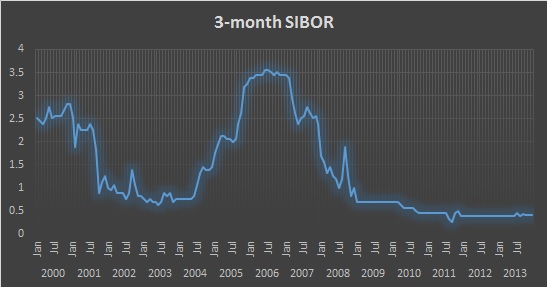 The Lakeshore is a 99-year lease condo in Jurong West. Photo: Lian Beng The Lakeshore is a 99-year lease condo in Jurong West. Photo: Lian Beng
Ever wondered why our CPF is paying interest rate that is so much higher than what the fixed deposits our banks are provided us? Furthermore, CPF board allows CPF contributors to put their CPF ordinary account (OA) amount into fixed deposits of banks. The Global Financial Crisis (GFC) of 2008/2009 has made the younger generation, especially those who just started working, feel that interest rates of below 1% is the norm. |
3.56% was the highest 3-month SIBOR since 2000
The Singapore Interbank Offered Rate (SIBOR) is generally the benchmark interest rates when it comes to floating mortgage interest rates. Typically, banks will price the mortgage repayments by adding a premium – about 1% – 2% – to the SIBOR.
What this means is that when the artificially low interest rate environment evaporates, when global economy goes back to the historical norms, we can expect mortgage interest rates to be at about 4% to 6% (3.56%+ 1% or 2%). Data: MAS / NextInsight chart
Data: MAS / NextInsight chart
We might potentially pay another 30% on our monthly mortgage
For simplicity, let us assume a $300,000 mortgage loan with a bank floating mortgage rate of premium of 1% + SIBOR.
Current 3-month SIBOR is at about 1.1%. Therefore, total mortgage interest rate would be 2.1%. If the loan term is 30 years, fully amortized monthly mortgage payment would work out to $1,124. If interest rates were to revert to its peak of 3.56% in the year 2006, mortgage rates will be 4.56%. This works out to a monthly mortgage payment of $1,538.
This translates into an extra $414 in cash outflow on a monthly basis, or a 37% increase.
If we are purchasing a pricier property (e.g. EC or private condominium) worth $800,000, the difference will be $2,997 v.s. $4,101 of monthly mortgage payments.
| Do not overestimate your ability to service a loan just because interest rates now look so attractive. We should always be prepared for hikes in mortgage rates. |
Interest rates are not expected to revert back to historical peaks YET
Globally, interest rates have been artificially depressed by central banks since the 2008 crisis, largely due to the fact that major nations have not yet recovered from the Great Recession derived from the GFC.
The European Central Bank and Bank of Japan (central banks of European Union and Japan) have even indulged in negative real interest rates to help alleviate its woes. Furthermore, global commodity prices have slumped so badly that we will not see massive and dangerous inflation taking place in the near future.
All indicators show that interest rates are here to stay at least for now, while these major economies lick their wounds and heal properly.
Nonetheless, we should always be wary because we would not know exactly when will the central banks increase interest rates again and at what pace. The Fed (central bank of USA) has already signaled that they are intending to slowly but surely increase its interest rates back up.
Do not overestimate your ability to service a loan just because interest rates now look so attractive. This is NOT the norm, and we should always be prepared for hikes in mortgage rates.





